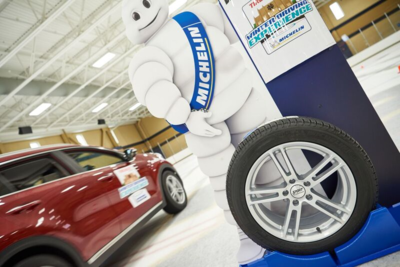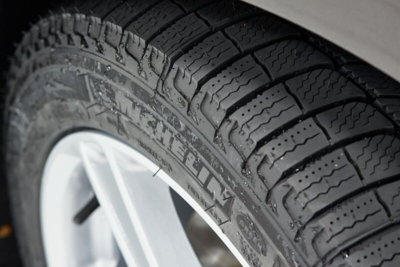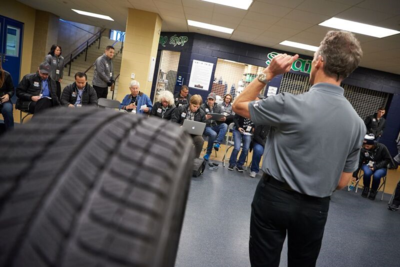Snow Tires Can Help Pave Way For Worry-free Winter Driving
By Maureen McDonald
Senior Editor
Michigan Bureau
The Auto Channel
As winter approaches, I'm already quivering with tension thinking about all the inept drivers on the road with inadequate tires. During the last snowstorm of 2017, a young driver slammed into my rear end as I waited to make a left turn into my neighborhood. The car was totaled and my back still feels the agony.
What became clear as asphalt in that instant of impact, is that caution isn't enough. Steering and stopping on snowy, icy roads or any combination of wintry mix is tricky because most all-season tires labor to grab the surface. The Federal Highway Administration claims 24 percent of all vehicle crashes are weather related.
What can I do to be safe? I took a couple days to practice winter driving techniques with the people from Michelin and Tire Rack in South Bend, Indiana. We took turns driving Kia SUVs on two ice arenas, comparing the Michelin X-Ice Xi3 snow tires and Michelin all-season tires. The "snows" allowed all of us to stop faster consistently with much less sliding. The all seasons were clearly misnamed.
I'd figured I'd be safe enough with all season tires and a good ABS/traction control system. All-season tires are engineered for a quiet ride, good tread life and fuel economy, but they lack the grip and sharp handling of a dedicated snow tire.
If the kid driving the Ford Taurus who totally crunched my VW Jetta rather abruptly had snow tires, he could have stopped squarely and quickly when he saw my tail lights and blinker. Nice clean stop instead of a messy slide that ended an inch from my gas tank. It was the automotive equivalent of an NHL charging penalty.
With snow tires on my Jetta, I could potentially make a quick left turn, assured I'd have the traction to complete the action without fishtailing, instead of waiting for a wide open lane.
Snow tires, according to Matt Edmonds, executive vice president of Tire Rack, a national online tire purveyor based in South Bend, said snow braking, handling, lateral adherence, low speed hill climbing and brakingare considerably enhanced by winter-specific tires. These tires are also capable of driving well on dry and wet conditions through cold weather months.
Newer snow tires are complex works of manufacturing art. They have cross sipes, these deep grooves designed to grip the pavement with room to spare, they have block edges that provide extra traction. The end blocks get their gripping power from the numerous sharp surrounding edges.
A driver still needs caution, but the tires grip the road and hold steady throughout the drive around town. An all-season tire stiffens and becomes brittle and thereby less agile in extreme cold whereas a snow tire like those of Michelin offers a combination of tread patterns to reduce snow buildup and sustain traction.
Would I need snow tires? Edmonds says anyone who drives through punishing winters could benefit. The price isn't cheap. I'd need four snow tires, wheels and tire monitoring systems for the best possible traction. I'd have to pay someone to put on the tires and find a place to store the all-season tires till spring, or even easier is to purchase a second set of wheels so changing out is as easy as can be.
The investment of say $1,000 initially and the cost of swapping wheels and tires twice a year might be about the same as the deductible for a car accident, whether fender bender or major crash. My 2010 VW Jetta was totaled out at $7,000, I'd paid $16,000 for it just five years ago, so a $9,000 loss. Not to mention a few thousand outlay in massages, chiropractic treatments and lost wages.
If four snow tires could steer me out of this kind of debt, I'm all in.






